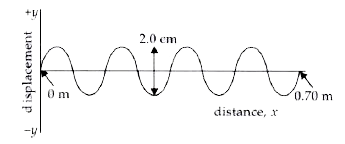A harmonic wave travelling in a medium has a period T and wavelength X. How far does the wave travel in time T ?
To solve the problem of how far a harmonic wave travels in time T, we can follow these steps:
Step 1: Understand the Definitions
- Wavelength (λ): This is the distance over which the wave's shape repeats. In this case, it is given as X.
- Period (T): This is the time taken for one complete cycle of the wave.
Step 2: Relate Distance, Time, and Wavelength
- A complete cycle of the wave travels a distance equal to its wavelength X in the time period T.
Step 3: Calculate Distance Travelled in Time T
- Since the wave travels a distance of X in the time T, we can conclude that in the time period T, the wave travels a distance equal to its wavelength.
Final Answer
Thus, the distance the wave travels in time T is X.
---
- Wavelength (λ): This is the distance over which the wave's shape repeats. In this case, it is given as X.
- Period (T): This is the time taken for one complete cycle of the wave.
- A complete cycle of the wave travels a distance equal to its wavelength X in the time period T.
- Since the wave travels a distance of X in the time T, we can conclude that in the time period T, the wave travels a distance equal to its wavelength.
Thus, the distance the wave travels in time T is X.
Similar Questions
A harmonic wave travelling in a medium has a period T and wavelength X. How are X and T related ?
View SolutionA wave represented by the given equationY=Asin(10πx+15πt+π3) , where x is in meter and t is in second. The expression represents
(1) A wave travelling in the negative X direction with a velocity of 1.5 m/sec
(2) A wave travelling in the negative X direction with a wavelength of 0.2 m
(3) A wave travelling in the positive X direction with a velocity of 1.5 m/sec.
(4) A wave travelling in the positive X direction with a wavelength of 0.2 mView Solution
Knowledge Check
- Question 1 - Select One
A harmonic wave is travelling along +ve x-axis, on a stretched string. If wavelength of the wave gets doubled, then
Afrequency of wave may changeBwave speed may changeCboth frequency and speed of wave may changeDonly frequency will change - Question 2 - Select One
A simple harmonic progressive wave in a gas has a particle displacement of y=a at time t=T/4 at the orgin of the wave and a particle velocity of y =v at the same instant but at a distance x=λ/4 from the orgin where T and λ are the periodic time and wavelength of the wave respectively. then for this wave.
Athe amplitude A of the wave is A=2aBthe amplitude A of the wave is A=aCthe equation of the wave can be represented by
yasin(v)a[(t)−xV]DThe equation of the wave can be represented by
y2acos(v)a[t−xV]
A harmonic wave is travelling in a stationary medium whose equation of this wave w.r.t. a frame which is moving along -ve x-axis with a constant speed v w.r.t. stationary medium. Also, find speed of wave in moving frame.
View SolutionA snapshot is taken of a periodic wave travelling on a string as shown below. What is the amplitude and wavelength of the wave?
 View Solution
View SolutionA sound wave travels 60m in the time taken to produce 50 waves. Find the wavelength of the sound wave in centimeters
View SolutionA sound wave travels 60m in the time taken to produce 50 waves. Find the wavelength of the sound wave in centimeters
View SolutionA source of wave vibrates with a frequency 500 Hz. The wave travels 33m in 0.1s . How far does the waves travels when the source executes 150 vibrations ?
View SolutionA sound wave travelling in a medium is represented as shown in the figure:

Which letter represents the wavelength of wave?View Solution

